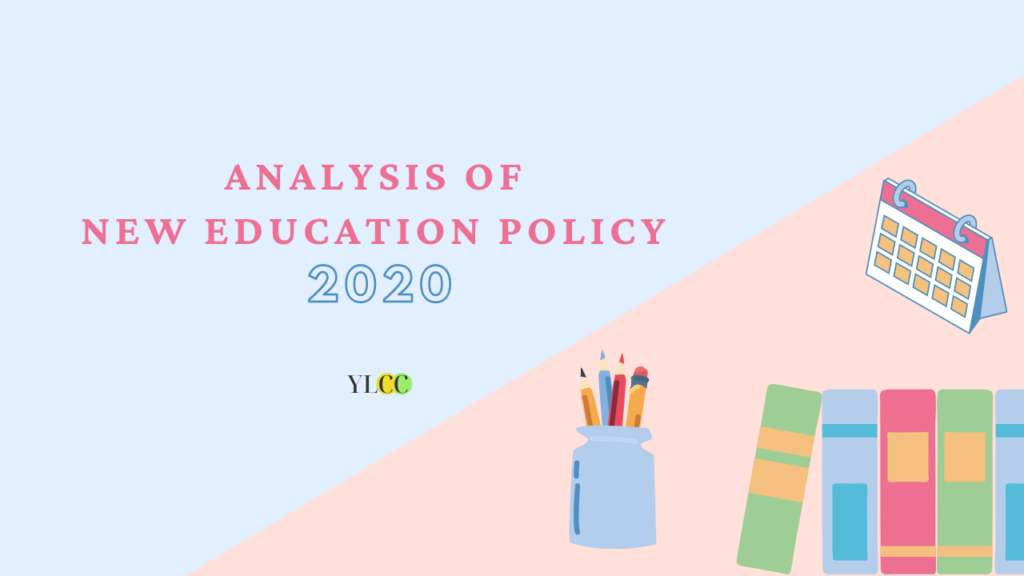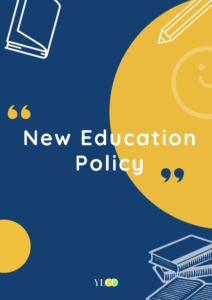
The National Education Policy 2020 (NEP 2020), which was approved by the Union Cabinet of India on 29 July 2020, outlined the vision of India’s new education system. The new policy replaces the previous National Policy on Education, 1986. The policy is a comprehensive framework for elementary education to higher education as well as vocational training in both rural and urban India. The policy aims to transform India’s education system by 2040.
In this article, we will study the main features of the policy and then analyse it in the light of its pros and cons.

Highlights of the NEP 2020
School Education
- Pre-school to secondary level education has been universalized with 100% Gross Enrolment Ratio (GER) by the year 2030. This will assist in bringing approx 2 crore children which are currently out of school, back into the mainstream.
- The current education system of 10+2 will be replaced by a new & revamped 5+3+3+4 structure which corresponds to the age group 3-8, 8-11, 11-14, and 14-18 years respectively.
- In the current scenario, the age group of 3-6 years is not covered in formal schooling, this will helps in bringing those age groups under the school curriculum. This age group is globally recognized as a crucial stage for the development of the mental ability of a child.
- This system will have 12 years of schooling with three years of Anganwadi / pre-schooling.
- Board examinations of class 10th & 12th will be made easier & will be focussed more on core competencies rather than memorized facts & rote learning.
- All students will be allowed to take these exams twice.
- A new accreditation framework will be set up along with an independent authority to regulate public and private schools. Foundational Literacy and Numeracy will be more focused.
- There will not be any rigid separation between academic streams, extracurricular activities & vocational streams in schools. A provision of Vocational education with internship from Class 6th.
- Mother tongue/regional language will be used for teaching up to class 5th & no language will be rigidly imposed on any students.
- A ‘National Curriculum Framework for Teacher Education (NCFTE)’ will be programmed by the National Council for Teacher Education (NCTE) in consultation with NCERT.
- A 4-years integrated B.Ed. degree course will be the minimum degree qualification for teaching by 2030.
Higher Education
- A target of 50% Gross Enrolment Ratio in higher education by 2035 which is currently at 26.3%. 3.5 crore seats will be added in higher education.
- Undergraduate courses will be imparted with a flexible curriculum of 3 or 4 years duration with multiple exit options and with certification at different levels.
- All the courses at undergraduate, postgraduate, and Ph.D. levels will be made interdisciplinary.
- M.phil. courses will be discontinued.
- ‘Academic Bank of Credits’ will be established which will facilitate Credit transfers.
- ‘Multidisciplinary Education and Research Universities (MERUs)’ will be established at par with IITs, IIMs as per the matching global standards.
- An apex body for fostering strong research culture namely ‘The National Research Foundation’ will be established which will serve the purpose of creating a strong research culture and building research capacity in higher education.
- ‘Higher Education Commission of India’ (HECI)’ will be established for entire higher education, excluding medical and legal education.
- Both the public and private higher education institutions will be governed by the same set of norms
- HECI will have four independent verticals i.e. :
1) National Higher Education Regulatory Council (NHERC) to look after the regulatory framework.
2) General Education Council (GEC) to look after standard settings.
3) Higher Education Grants Council (HEGC) to look after funding.
4) National Accreditation Council (NAC) to look after accreditation.
- The affiliation system of colleges will be wiped out in 15 years and a mechanism to be implemented for granting graded autonomy to colleges.
- In near future, every college is expected to develop as an autonomous degree-granting College or a constituent college of a university.
Pros of the Policy

- NEP 2020 has changed the structure from 10+2 to 5+3+3+4. It will include kindergarten of 3 years in formal schooling thus increasing the Gross Enrolment Ratio.
- Now, we can choose any subject from any academic streams as per the interest.
- Multiple exit options will provide enough flexibility to students to learn & work together with varying certification options at different levels.
- The importance of board exams is made less important thus reducing pressure on students reducing exam phobia.
- Now 6% of GDP will be used as a fund for the policy showing the importance of education.
- NEP 2020 will promote our Indian ethnic culture & hence unity in diversity will be promoted.
- Vocational learning will help students to be job-ready & more skill-oriented from their early ages.
- Higher education & standards of colleges will improve through a common HECI.
Cons of the Policy

- Regional and local languages will be promoted but somehow, English will take a back seat.
- It is important to acknowledge that English is the language of the world, Indian local & regional languages will not help that much at an International level.
- Imposing English in class 6th onwards will not give proper confidence & command in the English language to students.
- Implementing so many regional or local languages in different states will be difficult to assess whether they all are on the same platform or syllabus.
- English is recognized as a global language to communicate & in the IT industry and this is the reason we are booming in other countries than Chinese people.
Needless to say, all policies have their positive and negative aspects, and the National Education Policy is no different. However, the NEP seeks to implement a particular vision which if becomes a reality, shall definitely change the country’s education sector for the better.
YLCC would like to thank Sachet Labroo for his valuable inputs in this article.






